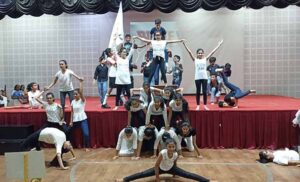Download our FREE Academic Calendar now! 📚 Start your child’s journey to success.
Sexual education for children is an important topic that parents and caregivers should address in order to provide children with the knowledge and skills they need to make informed decisions about their sexual health and well-being. In this article, we will discuss the key elements of sexual education for children and the benefits of starting this conversation early.
First, it is important to understand that sexual education for children is not just about teaching them about the physical aspects of sexuality. It is also about teaching them about healthy relationships, consent, and how to navigate the complex social and emotional aspects of sexuality. This includes teaching children about the importance of boundaries, respecting others’ boundaries, and understanding the difference between appropriate and inappropriate behaviour.
What is Sexual Education?
Sexual education means providing education to children about the human body, reproduction, relationships, and sexual health. There are different ways that children can be taught about sexual education such as by conducting sessions or special programs on the subject, while parents or guardians should also talk about it to their children at home. In addition, books, websites, and other resources should be utilised to provide children with accurate and age-appropriate information on sexual health.
One of the key components of sexual education is guiding children about different parts of the body, such as the reproductive organs, as well as how they work and change during puberty. They should also be taught how males and females bodies are unique, how babies are made and how the body changes during pregnancy, and different types of contraception, etc.
Sexual education is also about communicating effectively with others. This includes understanding the importance of consent and respecting boundaries, as well as learning how to build healthy relationships.
Finally, sexual education also includes learning about sexual health, understanding the importance of regular check-ups and how to protect oneself from sexually transmitted infections (STIs).
It’s important to remember that sexual education is an ongoing process, and children will continue to learn and grow as they get older. By providing them with accurate and age-appropriate information, parents and caregivers can help children develop healthy attitudes towards sexuality and relationships.
Importance of Sexual Education in School in Preventing Child Sexual Abuse?
Researchers stress on educating children early in order to prevent sexual misconduct.
If we try to guide them later in adulthood, by that time they might have been guided in the wrong direction through the medium of the Internet, Friends, porn sites, etc.
As educators, it is our goal and responsibility to guide students in the right direction. There are 2 important topics Consent and Healthy relationships,
that should be included while educating children about Sexual abuse and that too in safe and inclusive environment where they can freely discuss these topics.
Consent
It is not simple to explain to children about consent as they are exposed to various media where they see assault, harassment, sexual abuse etc through movies, and websites. They see various unhealthy relationships, dishonesty, seductive roles which provide misinformation which leads to sexual violence.
Consent is about more than these words “yes” or “no.” It’s when both people agree to indulge in sexual activities without feeling pressured. There are also terms like “token resistance” and “token compliance” which many people aren’t aware of.
Token resistance is when someone says “no” but really wants to say “yes,” because of the social stigma of the society related to sexual preferences.
Token compliance is when someone says “yes” but really wants to say “no,” because they feel if they didn’t do the opposite partner might leave them or be unhappy with them. To understand consent, we need to be honest about these things..
Some teachers feel uncomfortable discussing sexuality and consent with students because they don’t have enough information or don’t know how to talk about it in a way that’s appropriate for different age groups. A sexual education expert can provide the guidance and resources needed to make these conversations happen.
Teachers should be trained well regularly where school authorities take the responsibilities to get help from experts in sexual education. As teachers can help students understand the importance of affirmative consent.
Healthy Sexual Relationship
It means where you can express freely to your partner and understand your own thoughts and feelings. It is about knowing your own choices and having the power to control your own sexual experiences.
Creating a culture of consent means understanding and showing empathy.
Our teaching should not be focused on one group of people, we also need to look at different cultures, ethnicities, and religions and how they view love and sexual activities.
We should teach our children to ask permission before indulging in any act and understand that they have the right to control their own body. Schools must take this seriously and carry out action in making sure that children understand these important ideas.
Student’s Safety in Schools – Best Safety Measures Schools Should Implement
Sexual abuse is a serious issue that affects many students in schools across the country. In order to prevent this form of abuse, top schools in ahmedabad had implemented effective safety measures that address the issue head-on. Here are some of the best safety measures that schools should consider implementing to prevent sexual abuse.
Comprehensive Sexual Education
One of the most effective ways to prevent sexual abuse is through education. By providing students with comprehensive sexual education, schools can teach them about healthy relationships, consent, and personal autonomy. This will empower students to make informed decisions and recognize when they are in an unhealthy or abusive situation.
Employee Training
School staff and administrators need to be properly trained on how to recognize and respond to signs of sexual abuse. This includes training on how to identify warning signs, how to report abuse, and how to provide support for victims.
Safety Policies And Procedures
Schools should have clear policies and procedures in place to Protect Child from Sexual Assault. This includes having a designated person or team responsible for handling abuse reports, as well as procedures for conducting investigations and providing support for victims.
Safe and inclusive environments
It is responsibilities of school in safeguarding children and creating inclusive environments where students feel comfortable discussing sensitive topics such as sexual abuse. This includes having a zero-tolerance policy for any form of harassment or abuse, as well as providing support services for victims.
Parent and community involvement
Parents and community members play a critical role in preventing sexual abuse. Schools should involve parents and community members in discussions about sexual abuse and provide them with information about how to recognize signs of abuse and how to report it.
By implementing these safety measures, schools can work to prevent sexual abuse and create a safe and healthy environment for all students. It is important for schools to take a proactive approach to preventing sexual abuse and to involve the whole community in the efforts. Together we can create a culture of consent and ensure that our schools are safe for all students.
Conclusion
It is important to remember that Sexual Education for Students is an ongoing process. As children grow and develop, their understanding of sexuality and their needs will change. Parents and caregivers should continue to provide them with accurate information and support as they navigate this process.
They should be provided with the knowledge and skills they need to make informed decisions about their sexual health and well-being. This includes teaching them about anatomy and physiology, contraception and the risks associated with unprotected sexual activities, and healthy relationships. By starting the conversation early and providing ongoing support, parents and caregivers can help children to navigate the complex social and emotional aspects of sexuality.
Role of Sexual Education is crucial in preventing sexual abuse. By teaching children about consent, boundaries, and healthy relationships, we can empower them to protect themselves and recognize when something is not right. It’s also essential to provide education that is inclusive and considers different cultures, ethnicities, and religions. By working together, we can create a safer and more equitable society for all.
FAQs
What is the best age to give sexual education in school?
The best age to give sexual education in school is a topic of debate, but many experts agree that it should start in the late childhood and early teen years. This is because children at this age are beginning to develop their understanding of sexuality and relationships, and it is important to provide them with accurate information and guidance.
What preventive measures can be adopted by the school for the problematic child?
Preventive measures that schools can adopt for problematic children include early identification and intervention, providing a safe and supportive learning environment, and implementing behaviour management strategies. These can include regular check-ins with the child and their family, providing social-emotional support services, and utilising positive reinforcement techniques. Additionally, schools can also provide training and resources for teachers and staff to better understand and support children with behavioural challenges. Regular monitoring and evaluation of these measures can help ensure that the child is receiving the support they need to succeed.
What are the 5 safety rules in school?
1. “No Secret” rule: Children should be taught that there are no secrets when it comes to their safety and well-being. They should be encouraged to share any concerns or uncomfortable situations with a trusted adult.
2. “Say No” rule: Children should be taught that they have the right to say no to any form of physical touch that makes them uncomfortable, and they should be encouraged to speak out if they feel uncomfortable.
3. “Check First” rule: Children should be taught to ask for permission before touching or taking something that belongs to someone else.
4. “Body Safety” rule: Children should be taught about their bodies, privacy, and the importance of keeping their private parts private.
5. “Trusted Adults” rule: Children should be taught to identify a trusted adult, such as a teacher or parent, who they can turn to for help and support if they ever feel unsafe or uncomfortable.
How can teachers help abused students?
CBSE school Ahmedabad teachers are trained to help abused students by being aware of the signs of abuse and knowing how to respond appropriately. This includes recognizing physical and emotional signs of abuse, such as bruises, changes in behaviour, and reluctance to go home. Teachers should be trained to listen and believe the students, providing a safe and non-judgmental space for them to share their experiences. They can also offer support and referrals to appropriate services such as counselling, and reporting to the authorities when necessary. Additionally, teachers can provide a safe and supportive learning environment that helps the student to feel valued and respected. By providing this support, teachers can play a critical role in helping abused students to heal and move forward.
What is child protection in schools?
Child protection in schools refers to the measures and policies put in place to ensure the safety and well-being of students and Prevent Sexual Violence in School.
This includes preventing, identifying, and responding to child abuse and neglect, as well as promoting a safe and nurturing environment for learning. Child protection policies may include guidelines for reporting and responding to suspected abuse, background checks for staff and volunteers, and training for teachers and staff on how to recognize and respond to abuse. Additionally, schools may also provide resources and support for students and families who have experienced abuse. It’s essential that schools take a proactive approach to child protection to ensure the safety of all students.





































